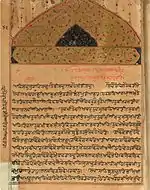Sukhmani Sahib
Sukhmani Sahib (Punjabi: ਸੁਖਮਨੀ ਸਾਹਿਬ) is usually translated to mean Prayer of Peace and joy of mind[1] is a set of 192 padas (stanzas of 10 hymns)[2] present in the holy Guru Granth Sahib, the main scripture and living Guru of Sikhism from Ang 262 to Ang 296 (about 35 count). This Gurbani text (writing of the Gurus) was written by the 5th Guru, Guru Arjan (1563–1606) at Amritsar in around 1602.[3] Guru Arjan first recited the bani at Gurdwara Barth Sahib in the Gurdaspur district of Punjab, India.

| Part of a series on |
| Sikh scriptures |
|---|
 |
| Guru Granth Sahib |
|
| Dasam Granth |
| Sarbloh Granth |
| Varan Bhai Gurdas |
Content
The composition deals with such topics such as Simran (general meditation that leads to merging with God)[4] and Nam Japna (meditation of Naam), the greatness of Saints and Sadh Sangat (holy congregation),[5] true devotion,[6] doing good deeds,[7] the nature of the mind, the badness of slandering,[8] concepts relating to Bhramvidya, Adviata, Sargun and Nirgun, materialism and death, Hukam, and other similar topics.[9] Below are a few translated lines from the first ashtpadi of the Sukhmani Sahib:[10]
Salok:
I bow to the Primal Guru.
I bow to the Guru of the ages.
I bow to the True Guru.
I bow to the Great, Divine Guru. ||1||
Ashtapadee:
Meditate, meditate, meditate in remembrance of Him, and find peace.
Worry and anguish shall be dispelled from your body.
Remember in praise the One who pervades the whole Universe.
His Name is chanted by countless people, in so many ways.
The Vedas, the Puraanas and the Simritees, the purest of
utterances,
were created from the One Word of the Name of the Lord Rama.
That one, in whose soul the One Lord dwells
- the praises of his glory cannot be recounted.
Those who yearn only for the blessing of Your Darshan
- Nanak: save me along with them!
Recitation
Sukhmani Sahib is frequently recited by Sikhs is one of the popular Banis (compositions of the Guru).[11] It can be done individually or as a group usually in either a place of worship (Gurdwara) or at home. Reciting the entire Sukhmani Sahib takes about 60[12] to 90 minutes, and is sometimes undertaken by everyone in a smaller congregation with turn by turn reading. Reciting the Gurbani of Sukhmani Sahib is believed to bring peace to one's mind[13] and aid help remembering God constantly.
Form
Sukhmani Sahib belongs to the Raag Gauri with Gauri meaning pure.[14] The term Sukhmani comprises two words: Sukh (peace) and Mani (the treasure or jewel of the mind)[15] It typically is found in Gutka form (small prayer book).
Structure
Sukhmani Sahib is divided into 24 Ashtpadi (Section). The Ashtpada is the Sanskrit word for a verse that has eight (Asht) metrical feet (pādi). Before the Ashtpadi begins there is a Salok of two lines and then each Ashtpadi contains eight padas of 10 hymns per pada.[16]
History
Sukhmani Sahib was composed by Guru Arjandev ji around 1602 before he compiled the Adi Granth. The Guru compiled it at Ramsar Sarovor (Sacred pool), Amritsar which at the time was in thick woods.[17]
Prominent Sikh saint Baba Nand Singh would tell Sikhs to recite Sukhmani Sahib twice daily.[18]
References
- N., Muthumohan (2003). "Reading Sukhmani Sahib". Abstracts of Sikh Studies. 5: 59.
- Singh, H. S. (2005). The Encyclopedia of Sikhism (over 1000 Entries) (Second ed.). New Delhi: Hemkunt Press. p. 190. ISBN 978-8170103011.
- Singh, Harbans (1998). The Encyclopaedia of Sikhism: S-Z. Patiala: Punjab University. p. 265. ISBN 9788173805301.
- Anand, Balwant (1979). Guru Tegh Bahadur, A Biography. New Delhi: Sterling Publishers. p. 229.
- Dhillon, Dalbir (1988). Sikhism Origin and Development. New Delhi: Atlantic Publishers and Distribution. p. 201.
- Kohli, Surinder. The Sikh and Sikhism. New Delhi: Atlantic Publishers & Distributors. p. 76.
- Singh, Indrajit (2008-10-20). Favourite Heroes and Holy People. A&C Black. p. 200. ISBN 9781441120151.
- Sikh Dharma Brotherhood. Sikh Dharma Brotherhood, Incorporated. 1975. p. xv.
- Chauhan, G.S. (2005). Shri Guru Nanak Dev's Japji. New Delhi: Hemkunt Press. p. 37. ISBN 9788170103141.
- Thind, Kulbir; Khalsa, Sant. Sukhmani Sahib with phonetic transliteration and English translation (PDF).
- Jean, Holm; Bowker, John (1994). Worship. A&C Black. p. 149. ISBN 9781855671119.
- The Sikh Review, Sikh Cultural Centre. 29: 13. 1981. Missing or empty
|title=(help) - Sethi, Manmohan (2014). Sukhmani Sahib: English Translation. Sukan Sethi. ISBN 9781502237149.
- Sharma, Arvind (2002). Methodology in Religious Studies: The Interface with Women's Studies. SUNY Press. p. 9. ISBN 9780791453476.
- Journal of Religious Studies Punjabi University. Dept. Of Religious Studies. 8: 118. 1980. Missing or empty
|title=(help) - "Semiotics of Simran in Sukhmani Sahib". Journal of Sikh Studies, Department of Guru Nanak Studies, Guru Nanak Dev University. 30: 95. 2006.
- Singh, Harbans (1998). The Encyclopaedia of Sikhism: S-Z. Patiala: Punjab University. p. 265. ISBN 9788173805301.
- Singh, Partap (1993). Eternal Glory of Baba Nand Singh Ji Maharaj of Kaleran, Part 1. Reliance Publishing House. p. 39. ISBN 978-81-85972-48-0.
.jpg.webp)